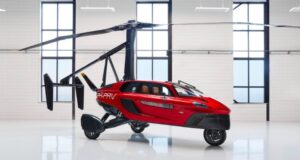The Ticker: Are Flying Cars Actually Launching Soon?
“Dude, where’s my flying car?”
The question has become something of a meme in recent years, asked in jest by people annoyed that the future is taking too long to arrive.
They may not have to wait much longer.
A number of tech firms, from plucky startups to aerospace giants, have set their sights on a loftier transit goal than autonomous cars. With a few exceptions, these companies are designing what might be called personal flying vehicles, to be summoned like a taxi. The idea is to create an alternative to ground transport in highly congested urban areas or to offer quick links between airports and downtowns.
A reason for skepticism is that for decades, flying cars have been just around the corner. Henry Ford famously promised a flying car in the 1940s, and every decade since has seen another madcap entrant into the race.
Uber’s flying car arm, Elevate, has partnered with five manufacturers in the hopes of launching an on-demand flying service. The ride-sharing company says it will begin test flights between Frisco, Texas and the Dallas-Fort Worth airport, with commercial trips getting off the ground in 2023. Last year Uber CEO Dara Khosrowshahi said at the company’s aviation industry summit that flying cars are part of a longer-term strategic growth plan.
“What you’re trying to do as a company is take growth that is coming in today and stage them and invest them in forward opportunities down the road … opportunities four years and six years and eight years from now,” Mr. Khosrowshahi said. “We’ll take short-term losses in order to bring long-term business.”
But ultimate ROI is not a sure thing, given the slew of competitors angling to be first to market with this new tech. The next four years may be something of a global sprint toward viability. In Japan, volunteer collective Cartivator—with funding from Toyota and Panasonic—hopes to have a model ready in time to light the Olympic torch at the 2020 Summer Games in Tokyo.
Though experts tell Bloomberg that Japan’s infrastructure will not realistically support flying cars until the late 2020s, the predictions have not stopped a number of companies—including Boeing and Airbus—from partnering with the government to pursue the technology.
Meanwhile, New Zealand has partnered with Google co-founder Larry Page to test his autonomous flying taxi, in the hopes that Mr. Page’s company, Kitty Hawk, will be able to set up a network of commercial routes in the island nation as early as 2021.
All of these target dates should probably be seasoned with a few grains of salt. In 2017, officials in Dubai promised that single-seat drones made by Chinese firm Ehang would begin taking flight that summer. While the vehicle performed thousands of successful test flights, it has yet to launch for real. Ehang filed what it called a “strategic bankruptcy” in 2018, claiming the move would set the company up for successful commercial production of the drone.
A deeper reason for skepticism is that for decades, flying cars have been just around the corner. Henry Ford famously promised a flying car in the 1940s, and every decade since has seen another madcap entrant into the race.
But if history is any guide, it is not the tech but safety regulations that might keep flying cars grounded for the near future. A big push from governments is probably necessary before flying cars will be ferrying executives to meetings any time soon.
This article appeared in the Summer 2019 issue of Insigniam Quarterly, with the headline “Are Flying Cars on the Horizon?” To begin receiving IQ, go here.




